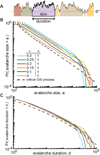Inhibition causes ceaseless dynamics in networks of excitable nodes
- PMID: 24745460
- PMCID: PMC4043283
- DOI: 10.1103/PhysRevLett.112.138103
Inhibition causes ceaseless dynamics in networks of excitable nodes
Abstract
The collective dynamics of a network of excitable nodes changes dramatically when inhibitory nodes are introduced. We consider inhibitory nodes which may be activated just like excitatory nodes but, upon activating, decrease the probability of activation of network neighbors. We show that, although the direct effect of inhibitory nodes is to decrease activity, the collective dynamics becomes self-sustaining. We explain this counterintuitive result by defining and analyzing a "branching function" which may be thought of as an activity-dependent branching ratio. The shape of the branching function implies that, for a range of global coupling parameters, dynamics are self-sustaining. Within the self-sustaining region of parameter space lies a critical line along which dynamics take the form of avalanches with universal scaling of size and duration, embedded in a ceaseless time series of activity. Our analyses, confirmed by numerical simulation, suggest that inhibition may play a counterintuitive role in excitable networks.
Figures



References
-
- Greenberg JM, Hassard BD, Hastings SP. Bull. Amer. Math. Soc. 1978;84(6):1296.
-
- Erola P, Diaz-Guilera A, Gomez S, Arenas A. Networks and Heterogeneous Media. 2012;7(3):385–397.
-
- Karrer B, Newman MEJ. Phys. Rev. E. 2011;84(3):036106. - PubMed
-
- Van Mieghem P. Europhysics Letters. 2012;97(4):48004.
-
- Dodds PS, Harris KD, Danforth CM. Phys. Rev. Lett. 2013;110:158701. - PubMed
Publication types
MeSH terms
Grants and funding
LinkOut - more resources
Full Text Sources
Other Literature Sources
